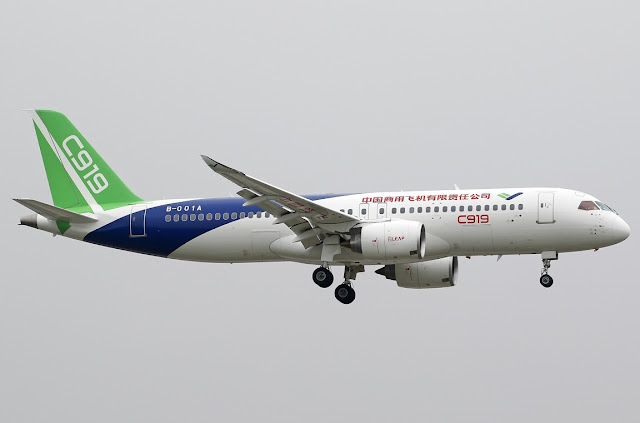U.S. could prevent China from buying GE engines
In a new phase of the U.S.-China trade war, the Trump administration is reportedly considering restricting the sale of jet engines and other aircraft components, according to sources in Reuters. Comac and its C919 is expected to compete with Boeing within a few years.
 |
| A C919 aircraft, with Leap engines (credits:Wikimedia) |
Towards restrictions?
According to the Reuters press agency, the United States could decide to restrict the export of General Electric engines and Honeywell parts, which make up the Comac C919. The components concerned are, for example, the Leap-1C, a perforated engine manufactured by CFM International, with the French company Safran.Honeywell supplies the APU, cockpit avionics, navigation and radio and landing gear. These are therefore strategic and vital parts, which, if they were missing, would delay the commercialization of the aircraft.
The issue is expected to be raised at a meeting on how to limit the export of U.S. technology to China on Thursday, February 20, 2020, and at another meeting with members of President Donald Trump's cabinet scheduled for February 28, according to some sources.
If the United States decides to impose new restrictions, one person familiar with the issue said, China could retaliate by ordering more planes from Airbus, rather than from Boeing, which is in crisis, with a quarter of its sales going to China.
People familiar with the issue said some administration officials are concerned that the Chinese will reverse-engineer some items.
 |
| A Leap engine on a Comac C919 aircraft on the ground (credits: Safran engines) |
China's Ambition
China is preparing to market its C919, a medium-haul aircraft produced by Comac, which is currently in the certification phase. The aim is to offer an aircraft that competes with the Airbus A320 and Boeing 737, capable of carrying 168 passengers over 5,500 km.This aircraft made its first flight on Friday 5 May 2017. On February 27, 2018, the C919 program recorded 815 orders from 28 customers (firm orders and call options).
However, despite significant financial support from the Chinese government, the C919 is encountering various technical difficulties. The nacelle and reactor appear to be subject to greater than expected forces, requiring reinforcement. Only one fifth of the flight hours required for certification by the Chinese authorities have been completed to date.
A strategic sector
Currently, the growth of Chinese air transport is based on European and American aircraft. In the future, China hopes to develop its own aviation industry. The country currently accounts for a quarter of the world's commercial aircraft fleet.By 2037, this figure is expected to reach 18%, according to a Boeing report. Among new deliveries, Boeing estimates that China will need 5,730 single-aisle aircraft by 2037, or 75 percent of its total fleet.



Comments
Post a Comment